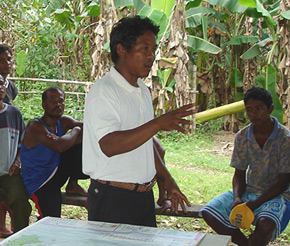
Coron Island hija arċipelagu mimli sikek tal-qroll, laguni salmastru, mangrovji, foresti tal-franka u bijodiversità li tiffjorixxi. Hemm għaxar lagi fiż-żona meqjusa bħala sagri mit-Tagbanwa Calamian, imsejħa Panyaan’s. Il-lagi huma wkoll rikonoxxuti uffiċjalment mill-istat bħala territorji antenati indiġeni. Quddiem pressjonijiet ta' żvilupp li qed jiżdiedu bħall-minjieri u s-sajd modern, huwa dubjuż jekk dan ir-rikonoxximent jipproteġix b'suċċess il-valuri kulturali u bijoloġiċi tal-artijiet Calamian Tagbanwa.
Il-Calamian Tagwawa huwa ħut nies li r-regoli konswetudini tagħhom jirregolaw is-sajd, inkluż li jiġi definit fejn is-sajd huwa permess. Żoni oħra jistgħu jiddaħħlu biss għall-użu kulturali meta jinkiseb il-permess tal-ispirti. Influss ta' dispjaċir ta' migranti u żgħażagħ li ma jaderixxux mar-regoli konswetudini jheddu dawn iż-żoni sagri. Il-modi aktar moderni tas-sajd tagħhom huma inqas sostenibbli u tradizzjonalment definiti żoni ristretti u r-regolamenti tas-sajd mhumiex rispettati. Il-Calamian Tagbanwa jemmnu li dawn il-ksur iħarbtu l-ispirti u l-qarnit mitoloġiku ġgant, Kunlalala, li jgħixu fil-lagi.
nies li r-regoli konswetudini tagħhom jirregolaw is-sajd, inkluż li jiġi definit fejn is-sajd huwa permess. Żoni oħra jistgħu jiddaħħlu biss għall-użu kulturali meta jinkiseb il-permess tal-ispirti. Influss ta' dispjaċir ta' migranti u żgħażagħ li ma jaderixxux mar-regoli konswetudini jheddu dawn iż-żoni sagri. Il-modi aktar moderni tas-sajd tagħhom huma inqas sostenibbli u tradizzjonalment definiti żoni ristretti u r-regolamenti tas-sajd mhumiex rispettati. Il-Calamian Tagbanwa jemmnu li dawn il-ksur iħarbtu l-ispirti u l-qarnit mitoloġiku ġgant, Kunlalala, li jgħixu fil-lagi.
Fortunatament ħafna żgħażagħ għadhom jirrispettaw it-tagħlim tal-anzjani. Soluzzjoni biex tiżgura ż-żamma taż-żoni sagri hija li tħarreġ lill-anzjani u l-komunitajiet biex jirreaġixxu għat-theddid li joħloq lill-artijiet tagħhom. Aspett wieħed ta 'dak huwa li tippermetti lill-anzjani u l-komunitajiet jorganizzaw laqgħat fejn l-għarfien tradizzjonali tagħhom huwa mgħallem lill-ġenerazzjoni li jmiss. B'dan il-mod il-ġenerazzjoni żagħżugħa hija involuta kontinwament bl-għarfien sagru u l-liġi konswetudinarja.
Għal aktar informazzjoni ara d-deskrizzjoni tas-sit fuq sit jew aqra l-istudju tal-każ li Arlene Sampang ħejja għall-ktieb: Siti naturali Sagra, konservazzjoni tan-natura & kultura, Kapitolu 24.
Billi: Rianne Doller






